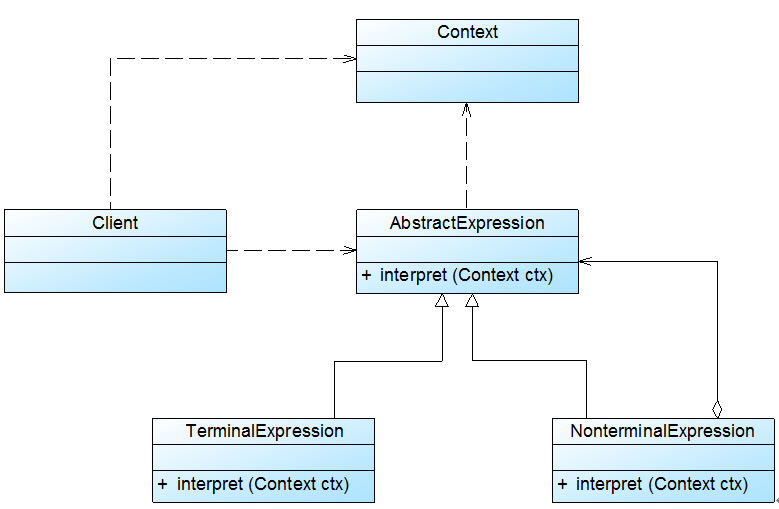expression ::= direction action distance | composite //表达式 composite ::= expression 'and' expression //复合表达式 direction ::= 'up' | 'down' | 'left' | 'right' //移动方向 action ::= 'move' | 'run' //移动方式 distance ::= an integer //移动距离
上述语言一共定义了五条文法规则,对应五个语言单位,这些语言单位可以分为两类,一类为终结符(也称为终结符表达式),例如direction、action和distance,它们是语言的最小组成单位,不能再进行拆分;另一类为非终结符(也称为非终结符表达式),例如expression和composite,它们都是一个完整的句子,包含一系列终结符或非终结符。

abstract class AbstractExpression { public abstract void interpret(Context ctx); } class TerminalExpression extends AbstractExpression { public void interpret(Context ctx) { //终结符表达式的解释操作 } } class NonterminalExpression extends AbstractExpression { private AbstractExpression left; private AbstractExpression right; public NonterminalExpression(AbstractExpression left,AbstractExpression right) { this.left=left; this.right=right; } public void interpret(Context ctx) { //递归调用每一个组成部分的interpret()方法 //在递归调用时指定组成部分的连接方式,即非终结符的功能 } }
除了上述用于表示表达式的类以外,通常在解释器模式中还提供了一个环境类Context,用于存储一些全局信息,通常在Context中包含了一个HashMap或ArrayList等类型的集合对象(也可以直接由HashMap等集合类充当环境类),存储一系列公共信息,如变量名与值的映射关系(key/value)等,用于在进行具体的解释操作时从中获取相关信息。其典型代码片段如下:
lass Context { private HashMap map = new HashMap(); public void assign(String key, String value) { //往环境类中设值 } public String lookup(String key) { //获取存储在环境类中的值 } }
抽象语法树如图18-4所示:

机器人控制程序实例基本结构如图18-5所示:

//注:本实例对机器人控制指令的输出结果进行模拟,将英文指令翻译为中文指令,实际情况是调用不同的控制程序进行机器人的控制,包括对移动方向、方式和距离的控制等 import java.util.*; //抽象表达式 abstract class AbstractNode { public abstract String interpret(); } //And解释:非终结符表达式 class AndNode extends AbstractNode { private AbstractNode left; //And的左表达式 private AbstractNode right; //And的右表达式 public AndNode(AbstractNode left, AbstractNode right) { this.left = left; this.right = right; } //And表达式解释操作 public String interpret() { return left.interpret() + "再" + right.interpret(); } } //简单句子解释:非终结符表达式 class SentenceNode extends AbstractNode { private AbstractNode direction; private AbstractNode action; private AbstractNode distance; public SentenceNode(AbstractNode direction,AbstractNode action,AbstractNode distance) { this.direction = direction; this.action = action; this.distance = distance; } //简单句子的解释操作 public String interpret() { return direction.interpret() + action.interpret() + distance.interpret(); } } //方向解释:终结符表达式 class DirectionNode extends AbstractNode { private String direction; public DirectionNode(String direction) { this.direction = direction; } //方向表达式的解释操作 public String interpret() { if (direction.equalsIgnoreCase("up")) { return "向上"; } else if (direction.equalsIgnoreCase("down")) { return "向下"; } else if (direction.equalsIgnoreCase("left")) { return "向左"; } else if (direction.equalsIgnoreCase("right")) { return "向右"; } else { return "无效指令"; } } } //动作解释:终结符表达式 class ActionNode extends AbstractNode { private String action; public ActionNode(String action) { this.action = action; } //动作(移动方式)表达式的解释操作 public String interpret() { if (action.equalsIgnoreCase("move")) { return "移动"; } else if (action.equalsIgnoreCase("run")) { return "快速移动"; } else { return "无效指令"; } } } //距离解释:终结符表达式 class DistanceNode extends AbstractNode { private String distance; public DistanceNode(String distance) { this.distance = distance; } //距离表达式的解释操作 public String interpret() { return this.distance; } } //指令处理类:工具类 class InstructionHandler { private String instruction; private AbstractNode node; public void handle(String instruction) { AbstractNode left = null, right = null; AbstractNode direction = null, action = null, distance = null; Stack stack = new Stack(); //声明一个栈对象用于存储抽象语法树 String[] words = instruction.split(" "); //以空格分隔指令字符串 for (int i = 0; i < words.length; i++) { //本实例采用栈的方式来处理指令,如果遇到“and”,则将其后的三个单词作为三个终结符表达式连成一个简单句子SentenceNode作为“and”的右表达式,而将从栈顶弹出的表达式作为“and”的左表达式,最后将新的“and”表达式压入栈中。
if (words[i].equalsIgnoreCase("and")) { left = (AbstractNode)stack.pop(); //弹出栈顶表达式作为左表达式 String word1= words[++i]; direction = new DirectionNode(word1); String word2 = words[++i]; action = new ActionNode(word2); String word3 = words[++i]; distance = new DistanceNode(word3); right = new SentenceNode(direction,action,distance); //右表达式 stack.push(new AndNode(left,right)); //将新表达式压入栈中 } //如果是从头开始进行解释,则将前三个单词组成一个简单句子SentenceNode并将该句子压入栈中 else { String word1 = words[i]; direction = new DirectionNode(word1); String word2 = words[++i]; action = new ActionNode(word2); String word3 = words[++i]; distance = new DistanceNode(word3); left = new SentenceNode(direction,action,distance); stack.push(left); //将新表达式压入栈中 } } this.node = (AbstractNode)stack.pop(); //将全部表达式从栈中弹出 } public String output() { String result = node.interpret(); //解释表达式 return result; } } class Client { public static void main(String args[]) { String instruction = "up move 5 and down run 10 and left move 5"; InstructionHandler handler = new InstructionHandler(); handler.handle(instruction); String outString; outString = handler.output(); System.out.println(outString); } }